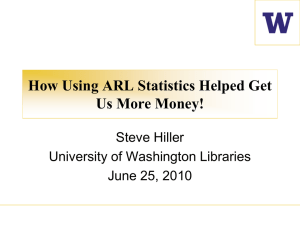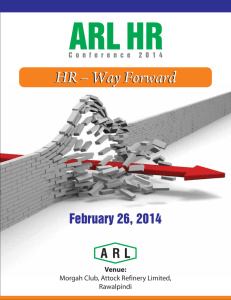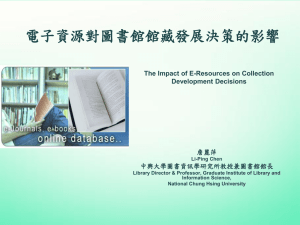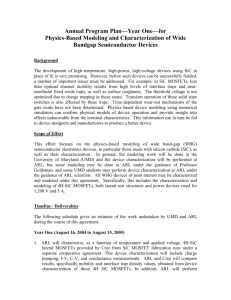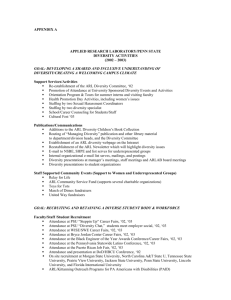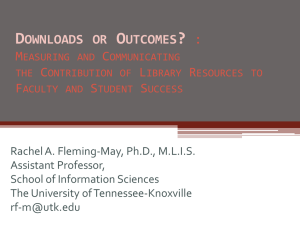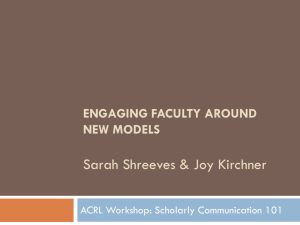ARL in the Next Three Years - Association of Southeastern
advertisement
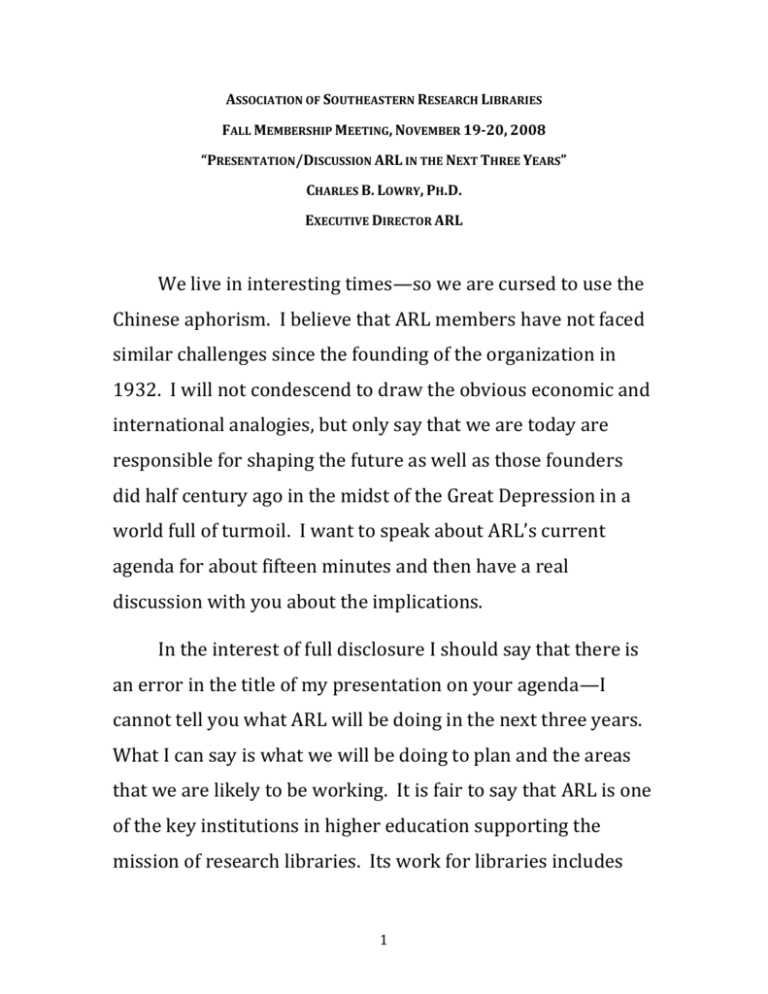
ASSOCIATION OF SOUTHEASTERN RESEARCH LIBRARIES FALL MEMBERSHIP MEETING, NOVEMBER 19-20, 2008 “PRESENTATION/DISCUSSION ARL IN THE NEXT THREE YEARS” CHARLES B. LOWRY, PH.D. EXECUTIVE DIRECTOR ARL We live in interesting times—so we are cursed to use the Chinese aphorism. I believe that ARL members have not faced similar challenges since the founding of the organization in 1932. I will not condescend to draw the obvious economic and international analogies, but only say that we are today are responsible for shaping the future as well as those founders did half century ago in the midst of the Great Depression in a world full of turmoil. I want to speak about ARL’s current agenda for about fifteen minutes and then have a real discussion with you about the implications. In the interest of full disclosure I should say that there is an error in the title of my presentation on your agenda—I cannot tell you what ARL will be doing in the next three years. What I can say is what we will be doing to plan and the areas that we are likely to be working. It is fair to say that ARL is one of the key institutions in higher education supporting the mission of research libraries. Its work for libraries includes 1 dealing with the development and legislation of key policy issues; providing leadership in transforming the scholarly communication landscape; helping seed the development of key best practices in extending the role of libraries in the research, teaching and scholarship; developing assessment services that provide research libraries (and others) key tools for improvement; and working to expand the pool of available candidates to seed leadership and diversity for research libraries. ARL works closely with the other national higher education associations to advance the mission of academy such as the Washington Higher Education Secretariat and the American Council on Education, NASULGC, and AAU. In addition, through the founding sponsorship of SPARC and CNI we have helped develop a forum that involves the larger academic library community in key discussions about technology and the world of scholarly publishing and helps leverage these two cooperatives for the larger interests we share. The mission for ARL is defined by our current strategic plan that was adopted for 2005-2012. That plan called for a midcourse review in 2009 for which we are currently organizing and which will be completed at the end of next year. It should be said that planning is actually a continuous effort at 2 ARL. We monitor the progress of the strategic plan in each of our four annual board meetings and the staff is constantly adjusting strategies through the steering committees for our three strategic directions. In summary, these are: Scholary Communications: ARL will be a leader in the development of effective, extensible, sustainable, and economically viable systems of scholarly communication. Public Policy: ARL will influence information and other public policies, both nationally and internationally, that govern the way information is managed and made available. Research, Teaching and Learning: ARL will promote and facilitate new and expanding roles for ARL libraries in the transformations affecting research and undergraduate Two the strategic directions must be added two important enabling capabilities that are also built into our strategic plan: Our Diversity and Leadership Program and also Our Statistics and Measurement Program These are understandable directions for ARL, but what they are intended to achieve is perhaps more to the point and is outlined in our preferred future. There are ten: 3 1. In 2012, ARL will have a strong focus on policy matters. It will be a primary advocate for the educational and research interests in the formulation of information and other public policies that have an impact on research libraries and systems of scholarly communication. It will provide leadership in advocacy and educational efforts to inform institutional policies and individual practices that influence research, teaching, and learning. With a high profile on policy issues, ARL will be an organization to which the media turns. 2. In 2012, ARL will provide leadership in the transformation of scholarly communication. ARL will support and facilitate the emergence of economically sustainable channels where content is openly available to the scholarly and scientific communities along with associated services that maximize enduring discovery and interdisciplinary use of the content. 3. In 2012, ARL's influence will be global in scope with powerful national, North American, and international collaborations. It will take a leadership role in framing key policy issues and seek allies with shared goals to advance a policy position. 4 4. In 2012, ARL will have an expanded focus on library contributions to the research process as well as to teaching and learning. By articulating directions, showcasing demonstrations, and developing assessment strategies, ARL will have enabled research libraries to expand their contributions and visibility 5. In 2012, ARL's leadership and governance will reflect the diversity of its member libraries' interests, demonstrate agility by responding to the changing needs of its member libraries, and provide multiple opportunities to engage member representatives as well as library staff beyond the library director's position. 6. In 2012, ARL’s member representatives will be active in and supportive of the organization and recognize its value to the field. Affinity groups will allow member representatives to congregate around common interests. 7. In 2012, ARL will have rationalized its relationship with the other organizations in the research library community, reducing redundancy and creating a dynamic, collaborative environment that will be able to serve the diverse needs of research libraries. 5 8. In 2012, ARL‘s mission will be sharply focused, and the initiatives it funds and undertakes will avoid “mission creep.” 9. In 2012, ARL will be fiscally stable and strong, with appropriate financial and human resources—both member representatives and staff—to support its work. 10. In 2012, ARL will have strategic planning and organizational assessment as core Association competencies. How does all this fit with a variety of regional consortia who’s membership overlaps with ARL’s—GWLA, Ivies Plus, CIC, and of course ASERL. The primary distinction that I would draw is the operational dimension of the regional consortia. Projects like digitization, collection development, FDLP cooperation have an operational dimension that is not present in ARL programs. It is true that we offer services like LibQUAL, ClimateQUAL, and MINES, but these are quite different. In the past ARL has had operational programs, most recently The Global Resources Program that was developed to address the decline in the collective ability of research libraries to acquire and ensure access to a wide range of foreign materials at a time of static budgets. I should point out that this program has been 6 passed to the Center for Research Libraries. I would expect that any future operational initiatives will be treated in a similar fashion. Similarly, ARL recently appointed a Federal Depository Working Group where our 22 Regional Depository members and dozens of Selective Depositories have a forum to work on issues that can help us advance the initiatives of modernizing the way in which government publications are managed. But, let me emphasize we are working in the policy and legislative framework, not in the operational arena. That is not to say members will not have discussions that possibly initiate operational efforts, but ARL will not be the locus for their management if and when they emerge. So, how and why should ARL’s work be of importance to an ASERL audience besides the fact that half of your members also belong to ARL. It seems pretty transparent to me. The primary forces of change that we face are easy to recognize and they are not of our making—shifts in pedagogy and research; the transformational impact of networked information technology; a revolution in scholarly information and in the intellectual property regime; and the ever-present restraint of budget. On the other hand, I think one thing remains unchanged—the core mission of academic and research libraries—delivering access to the world of scholarly 7 information to support learning in the classroom and the discovery of new knowledge and invention. ASERL libraries are daily adapting that historic mission to the changing landscape. That is easy to say but hard to do. Given the large overlapping involvement of our organizations, we can best overcome these challenges through an understanding of our distinctive roles as associations and commit ourselves to close cooperation and convergence around issues. Or to crib from Ben Franklin—“We must hang together, or assuredly we shall hang separately.” 8

